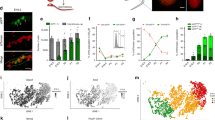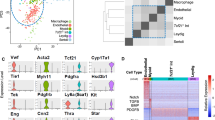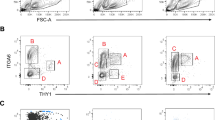Abstract
In adults, stem cells are responsible for the maintenance of many actively renewing tissues, such as haematopoietic, skin, gut and germinal tissues. These stem cells can self-renew or be committed to becoming progenitors. Stem-cell commitment is thought to be irreversible but in male and female Drosophila melanogaster, it was shown recently that differentiating germ cells can revert to functional stem cells that can restore germinal lineage1,2. Whether progenitors are also able to generate stem cells in mammals remains unknown. Here we show that purified mouse spermatogonial progenitors committed to differentiation can generate functional germinal stem cells that can repopulate germ-cell-depleted testes when transplanted into adult mice. We found that GDNF, a key regulator of the stem-cell niche, and FGF2 are able to reprogram in vitro spermatogonial progenitors for reverse differentiation. This study supports the emerging concept that the stem-cell identity is not restricted in adults to a definite pool of cells that self-renew, but that stemness could be acquired by differentiating progenitors after tissue injury and throughout life.
This is a preview of subscription content, access via your institution
Access options
Subscribe to this journal
Receive 12 print issues and online access
$209.00 per year
only $17.42 per issue
Buy this article
- Purchase on Springer Link
- Instant access to full article PDF
Prices may be subject to local taxes which are calculated during checkout





Similar content being viewed by others
References
Kai, T. & Spradling, A. Differentiating germ cells can revert into functional stem cells in Drosophila melanogaster ovaries. Nature 428, 564–569 (2004).
Brawley, C. & Matunis, E. Regeneration of male germline stem cells by spermatogonial dedifferentiation in vivo. Science 304, 1331–1334 (2004).
de Rooij, D. G. Proliferation and differentiation of spermatogonial stem cells. Reproduction 121, 347–354 (2001).
Schrans-Stassen, B. H., van de Kant, H. J., de Rooij, D. G. & van Pelt, A. M. Differential expression of c-kit in mouse undifferentiated and differentiating type A spermatogonia. Endocrinology 140, 5894–5900 (1999).
Ohta, H., Yomogida, K., Dohmae, K. & Nishimune, Y. Regulation of proliferation and differentiation in spermatogonial stem cells: the role of c-kit and its ligand SCF. Development 127, 2125–2131 (2000).
Yoshida, S. et al. Neurogenin3 delineates the earliest stages of spermatogenesis in the mouse testis. Dev. Biol. 269, 447–458 (2004).
Raverot, G., Weiss, J., Park, S. Y., Hurley, L. & Jameson, J. L. Sox3 expression in undifferentiated spermatogonia is required for the progression of spermatogenesis. Dev. Biol. 283, 215–225 (2005).
Tokuda, M., Kadokawa, Y., Kurahashi, H. & Marunouchi, T. CDH1 is a specific marker for undifferentiated spermatogonia in mouse testes. Biol. Reprod. 76, 130–141 (2007).
Shinohara, T., Orwig, K. E., Avarbock, M. R. & Brinster, R. L. Spermatogonial stem cell enrichment by multiparameter selection of mouse testis cells. Proc. Natl Acad. Sci. USA 97, 8346–8351 (2000).
Bastos, H. et al. Flow cytometric characterization of viable meiotic and post-meiotic cells by Hoechst 33342 in mouse spermatogenesis. Cytometry A 65, 40–49 (2005).
Lassalle, B. et al. 'Side population' cells in adult mouse testis express Bcrp1 gene and are enriched in spermatogonia and germinal stem cells. Development 131, 479–487 (2004).
Zhang, X., Ebata, K. T. & Nagano, M. C. Genetic analysis of the clonal origin of regenerating mouse spermatogenesis following transplantation. Biol. Reprod. 69, 1872–1878 (2003).
Shinohara, T., Avarbock, M. R. & Brinster, R. L. beta1- and alpha6-integrin are surface markers on mouse spermatogonial stem cells. Proc. Natl Acad. Sci. USA 96, 5504–5509 (1999).
Kubota, H., Avarbock, M. R. & Brinster, R. L. Culture conditions and single growth factors affect fate determination of mouse spermatogonial stem cells. Biol. Reprod. 71, 722–731 (2004).
Shinohara, T., Orwig, K. E., Avarbock, M. R. & Brinster, R. L. Remodeling of the postnatal mouse testis is accompanied by dramatic changes in stem cell number and niche accessibility. Proc. Natl Acad. Sci. USA 98, 6186–6191 (2001).
Falciatori, I. et al. Identification and enrichment of spermatogonial stem cells displaying side-population phenotype in immature mouse testis. FASEB J. 18, 376–378 (2004).
Kubota, H., Avarbock, M. R. & Brinster, R. L. Spermatogonial stem cells share some, but not all, phenotypic and functional characteristics with other stem cells. Proc. Natl Acad. Sci. USA 100, 6487–6492 (2003).
Chen, C. et al. ERM is required for transcriptional control of the spermatogonial stem cell niche. Nature 436, 1030–1034 (2005).
Meng, X. et al. Regulation of cell fate decision of undifferentiated spermatogonia by GDNF. Science 287, 1489–1493 (2000).
Bedell, M. A. & Mahakali Zama, A. Genetic analysis of Kit ligand functions during mouse spermatogenesis. J. Androl. 25, 188–199 (2004).
Heissig, B. et al. Recruitment of stem and progenitor cells from the bone marrow niche requires MMP-9 mediated release of kit-ligand. Cell 109, 625–637 (2002).
Kubota, H., Avarbock, M. R. & Brinster, R. L. Growth factors essential for self-renewal and expansion of mouse spermatogonial stem cells. Proc. Natl Acad. Sci. USA 101, 16489–16494 (2004).
Yeh, J. R., Zhang, X. & Nagano, M. C. Establishment of a short-term in vitro assay for mouse spermatogonial stem cells. Biol. Reprod. 77, 897–904 (2007).
de Rooij, D. G. & Grootegoed, J. A. Spermatogonial stem cells. Curr. Opin. Cell Biol. 10, 694–701 (1998).
Nakagawa, T., Nabeshima, Y. & Yoshida, S. Functional identification of the actual and potential stem cell compartments in mouse spermatogenesis. Dev. Cell 12, 195–206 (2007).
Hanna, J. et al. Direct reprogramming of terminally differentiated mature B lymphocytes to pluripotency. Cell 133, 250–264 (2008).
Aoi, T. et al. Generation of pluripotent stem cells from adult mouse liver and stomach cells. Science 26, 101–106 (2008).
Ryu, B. Y., Orwig, K. E., Oatley, J. M., Avarbock, M. R. & Brinster, R. L. Effects of aging and niche microenvironment on spermatogonial stem cell self-renewal. Stem Cells 24, 1505–1511 (2006).
Akala, O. O. et al. Long-term haematopoietic reconstitution by Trp53−/−p16Ink4a−/−p19Arf−/− multipotent progenitors. Nature 453, 228–232 (2008).
Guan, K. et al. Pluripotency of spermatogonial stem cells from adult mouse testis. Nature 440, 1199–1203 (2006).
Seandel, M. et al. Generation of functional multipotent adult stem cells from GPR125+ germline progenitors. Nature 449, 346–350 (2007).
Boulanger, C. A., Mack, D. L., Booth, B. W. & Smith, G. H. Interaction with the mammary microenvironment redirects spermatogenic cell fate in vivo. Proc. Natl Acad. Sci. USA 104, 3781–3786 (2007).
Okabe, M., Ikawa, M., Kominami, K., Nakanishi, T. & Nishimune, Y. 'Green mice' as a source of ubiquitous green cells. FEBS Lett. 407, 313–319 (1997).
Acknowledgements
We thank P.H. Romeo for critical review of the manuscript and helpful comments. We thank M. Okabe for the generous gift of the EGFP transgenic mice; S. Leblay and V. Neuville for their technical assistance in the animal facilities, and T. Andrieu for assistance with Aria, LSR and LSRII. This work was supported in part by a grant from Electricité De France.
Author information
Authors and Affiliations
Contributions
V.B. and B.L. contributed equally to the experimental work, with help from M.C., L.R.and P.F.; V.B., B.L., L.R. and P.F. conceived and designed the experiments; J.P.L. provided valuable material and initiated the breeding of the EGFP mice; F.L.P., J.T., I.A., B.L. and L.R. revised the manuscript. All authors participated in data analysis. P.F. coordinated the study; P.F. and V.B. wrote the paper.
Corresponding author
Ethics declarations
Competing interests
The authors declare no competing financial interests.
Supplementary information
Supplementary Information
Supplementary Information (PDF 341 kb)
Rights and permissions
About this article
Cite this article
Barroca, V., Lassalle, B., Coureuil, M. et al. Mouse differentiating spermatogonia can generate germinal stem cells in vivo. Nat Cell Biol 11, 190–196 (2009). https://doi.org/10.1038/ncb1826
Received:
Accepted:
Published:
Issue Date:
DOI: https://doi.org/10.1038/ncb1826
This article is cited by
-
EZHIP constrains Polycomb Repressive Complex 2 activity in germ cells
Nature Communications (2019)
-
Understanding the colon cancer stem cells and perspectives on treatment
Cancer Cell International (2015)
-
RA induces differentiation of multipotent P19 cells towards male germ cell
In Vitro Cellular & Developmental Biology - Animal (2015)
-
Hypothermia Stimulates Glioma Stem Spheres to Spontaneously Dedifferentiate Adjacent Non-stem Glioma Cells
Cellular and Molecular Neurobiology (2015)
-
The Roles of Testicular C-kit Positive Cells in De novo Morphogenesis of Testis
Scientific Reports (2014)



